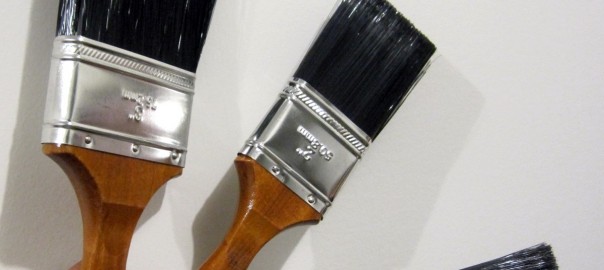The best brushes for staining furniture are those that work on multiple furniture projects. Brushes are the most versatile stain applicator. They’re used to apply clear, semi-transparent or semi-solid viscous stains. Brushes are used to apply solid color stains over previous coats of paint or solid stains. Brushes can be used to apply stains to raw new surfaces or those previously stains. Brushes allow for greater application control and offer deep penetration of stain into wood pores.
High Quality Stain Brushes
Buy the best quality brushes you can afford and then clean thoroughly after use. They will be worth the cost. Professional painters purchase the best brushes and maintain these high quality brushes for years, as these are literally the tools of their profession. Get a good tool once and use it for years. Do not buy something that will cause frustration and become a throwaway after one use.
Good brushes make the task of applying stain easier: the brushes hold larger amounts of product, allowing the painter to make a smooth, even application in less time. The best brush makes the finished stain look better, too. Delivering more stain into the wood with each stroke and allowing it to lock and dry properly.
A lesser quality brush can cause the painter to exert 25 percent more effort, and a poor quality brush adds up to 80 percent more time to the project, says author Tom Philbin in “Perfect Exterior Staining.” (2004) A poor quality brush could add up to three hours to a four-hour furniture project. Philbin says that the poor quality brush won’t yield as attractive results even with extra effort!
Natural Bristles For Staining Cabinets
When applying oil-based stains, use only natural bristle brushes. These natural hair bristles are sometimes called “China bristle” because many of the wild hogs or boars used to make the bristles originate there.
If you insist on buying cheap brushes, make sure to remove the loose bristles. Bristles that come off the brush when staining or painting will stick to whatever you are working on. To fix this problem get some tape and wrap it around your hand; adhesive on the outside. Then press the tape on the brush. Keep doing this until all the loose bristles are off. A sticky lint roller works well for this too.
Cabinet stains come in oil and water-based varieties. If using a traditional oil-based type, use a natural brush. To protect the wood from stain blotches, use a thin coat of wood conditioning before applying stain. The conditioner should stay on the wood for 10 to 15 minutes to dry. (No need to sand the conditioner.)
- Stir the oil-based stain before applying to make sure the pigments and dyes mix with the mineral spirits.
- Apply the stain to cabinets with a brush, working with and against the grain.
- Focus on putting a generous coat of stain on the wood.
- To lighten the stain, wipe some off; to deepen the stain, leave on for at least five to 10 minutes prior to wiping.
All excess stain in the direction of the wood grain should be removed: this step guarantees that the stain has soaked into the wood and shows the wood grain to advantage.
Expect to pay at least $25-$30 for a high quality brush suitable for cabinet work. Avoid natural bristles with water-based stain. Natural bristles absorb too much product–as much as 40 percent of the hollow bristles fill up for a soggy result. Older brushes (manufactured before World War II) are always natural hair brushes. Paint from that era was oil-based.
Synthetic Bristles For Decks
Water-based deck stains continue in popularity because these stains are longer-lasting and durable when compared to oil-based varieties. Water-based formulas are easier to use: the water-based stains wash with soap and warm water. Because they aren’t made with solvents, painters breathe freely. Water-based deck stains wear better and are resistant to the elements. Wood needn’t be fully dry to use the oil-based stain. They dry faster than oil-based varieties and they’re a better green alternative. A high quality synthetic brush for the deck starts at about $50, and the stain brush can be used to maintain the deck when it starts to discolor or gray. Add wood brightener, then a light coat of stain to seal.
Disposable foam brushes work well for application of polyurethane. To avoid the challenge of cleaning this sticky substance from fine bristle brushes, or for a fast touch-up, foam brushes save the day. If you really need a throwaway stain applicator, foam brushes are your best bet. They provide a good surface area staining and can be cheap enough to toss out. They can cost $1-$3 for a simple small to medium sized brush.

